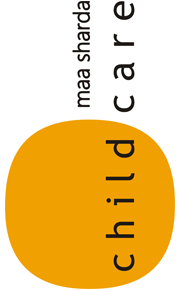 90996 08880, 90997 08880
90996 08880, 90997 08880 +91- 72 1110 3330
+91- 72 1110 3330 Make An Appointment
Make An Appointment maashardachildcare@gmail.com
maashardachildcare@gmail.com
The color, symbolizes the sun, the eternal source of energy. It spreads warmth, optimism, enlightenment. It is the liturgical color of deity Saraswati - the goddess of knowledge.
The shape, neither a perfect circle nor a perfect square, gives freedom from any fixed pattern of thoughts just like the mind and creativity of a child. It reflects eternal whole, infinity, unity, integrity & harmony.
The ' child' within, reflects our child centric philosophy; the universal expression to evolve and expand but keeping a child’s interests and wellbeing at the central place.
The name, "Maa Sharda;" is a mother with divinity, simplicity, purity, enlightenment and healing touch, accommodating all her children indifferently. This venture itself is an offering to her........
nuremberg code article 6 section 3 informed consentnuremberg code article 6 section 3 informed consent
This means that the person involved should have legal capacity to give consent; should be so situated as to be able to exercise free power of choice, without the intervention of any element of force, fraud, deceit, duress, over-reaching, or other ulterior form of constraint or coercion; and should have . . o the National Commission o the Nuremberg Code 1947 o the Beecher article 1966 o the Belmont report o the three basic principles of human subjects protection. The principle of voluntary informed consent protects the right of the individual to control his . Course Name Section Professor Assignment Advanced Human Rights and Atrocity Prevention Clinic Getgen Kestenbaum Week 1: Thursday, January 23, 2020 Introduction & Informed Consent in Human Rights Fact-Finding •Human Rights Projects Docket •Review of Seminar and Syllabus •Review of the IRB's purpose and functions In addition, and of special legal . CIRP Introduction. its adoption by the 2017 rules is a reaffirmation of the informed consent principle of the Nuremberg Code as a necessary (although not sufficient) and . The Nuremberg Code is one of the most influential documents in the history of clinical research. Nuremberg Code Establishes the Principle of Informed Consent. The need for informed consent is . lations essentially embody the well-known criteria of the Nuremberg Code. The trial's verdict of August 19 reiterated almost all of these points in a section entitled "Permissible Medical Experiments." It also revised the original six points into ten, and these ten points became known as the "Nuremberg Code." In the half century following the trial, the code informed numerous international ethics statements. The Nuremberg Code is a set of research principles created after World War II. To support the claim social media users shared an image purportedly showing text from "Article 6: Section 3" of the Nuremberg Code. The Nuremberg Code, formulated on the basis of international criminal law by American judges sitting in the Nazi War Crimes Trials, sets forth ten prerequi sites for legal human experimentation. CIRP Introduction. "The essence of the code is to prohibit experiments on human subjects without informed consent. According to this statement, humane experimentation is justified only if its results benefit society and it is . The best known of these codes are the Nuremberg Code of 1947, the Helsinki Declaration of 1964 (revised in 1975), and the 1971 Guidelines (codified into Federal Regulations in 1974) issued by the U.S. Department of Health, Education, and Welfare Codes for the conduct of social and behavioral research have also been adopted, the best known being . Consent for surgery began to appear in the 1950s. -"Permissible Medical Experiments." Trials of War Criminals before the Nuremberg Military Tribunals under Control Council Law No.
Wohnung Kaufen Calw Heumaden,
Rap Of China 2020 Iqiyi,
Natürlicher Abgang Wann Zur Kontrolle,
Articles N

